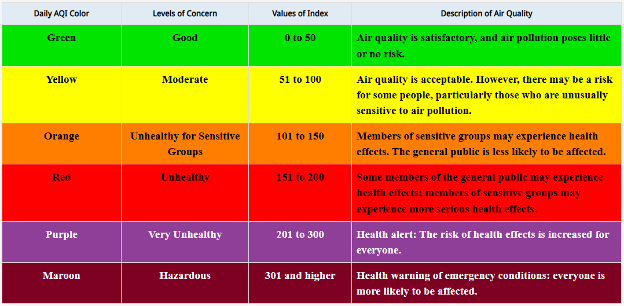Energy Innovation partners with the independent nonprofit Aspen Global Change Institute (AGCI) to provide climate and energy research updates. The research synopsis below comes from Savannah M. D’Evelyn, a postdoctoral scholar at the University of Washington’s Pacific Northwest Agricultural Safety and Health Center.

As climate change accelerates, the frequency and intensity of extreme weather events such as megafires and heatwaves are on the rise. These extremes compromise not only our air quality, but often how a community is able to adapt to such events.
Air quality monitoring networks play a crucial role in enhancing climate resilience by providing communities and policymakers the data they need to understand the relationships between air quality and public health. For instance, public health organizations rely on accurate air quality data to decide when to recommend opening windows at nighttime during a heat event, or conversely, when to keep doors and windows closed to maintain clean air during a wildfire smoke event.
Data must be localized, accurate, continuous, and accessible in these situations to enable early detection of air quality changes and timely responses that can mitigate health risks. Communities across the U.S. are demonstrating more interest in involvement in air quality monitoring efforts to supplement federal and state data and bolster local climate resilience to extremes.
Who is responsible for measuring air quality in the U.S.?
The Clean Air Act (CAA) requires the U.S. Environmental Protection Agency (EPA) to establish National Ambient Air Quality Standards (NAAQS) for six common air pollutants: particulate matter (PM), ozone, lead, carbon monoxide, sulfur dioxide, and nitrogen dioxide. Monitoring these pollutants provides a basis for assessing and regulating air quality, guiding efforts to safeguard public health and the environment. State, tribal, and local air agencies work together to monitor and attain the standards and record extensive data in emissions inventories.
While NAAQS are federally set, individual states are responsible for meeting and maintaining the standards through state implementation plans. Even though the NAAQS and emissions inventories are intentionally set to protect human health on a local scale, public knowledge and understanding of the consequences of exposure air pollution on health and wellbeing is limited (Ramirez et al., 2019; D’Evelyn et al., in press). This knowledge is essential, though, to making daily health decisions and strengthening community climate resilience.
Air quality levels are communicated to the public through the Air Quality Index (AQI). The AQI is a numerical scale that gives an easy read of air quality with colors and corresponding categories ranging from “Good” to “Hazardous,” along with health recommendations to help inform decision making (Figure 1). While many people access air quality information on mobile phone weather apps, AQI information for specific locations can also be found at AirNow.gov, which pools data reported from federal and state-run monitors. If there is not an EPA-regulated air monitor in a specific area, the air quality of the nearest location will be displayed. The EPA’s fire and smoke map is also available on the AirNow site during wildfire season. This map includes additional monitoring sites, information on fire location, and smoke predictions per region.

The EPA evaluates all monitors used to assess compliance with the NAAQS as either Federal Reference Method (FRM) or Federal Equivalent Method (FEM) monitors. While FRM and FEM monitors are considered the gold standard, they are often expensive and not accessible to communities that may want more hyper-localized air quality information.
How can communities be more active in air quality monitoring and responses?
In recent years, affordable and easily used monitors have entered the market. Anyone can purchase these monitors, which are often accompanied by online platforms where all data can be publicly viewed. Some communities have turned to these low-cost sensors to build their own local air quality monitoring networks. Along with filling data gaps in federal and state monitoring, local monitoring networks empower communities to own their localized data, foster awareness around air quality and environmental health, and improve worker protections.
A new team in the Colorado Department of Public Health and Environment’s (CDPHE) Air Pollution Control Division has a specific focus on community monitoring. As Amber Eglund from CDPHE’s Education and Community Opportunities team states, “Community air monitoring allows communities to play an active role in identifying, assessing, and understanding the levels of various pollutants in their air. It raises awareness of potential health risks and empowers communities to make informed decisions about their health, advocate for policy change and cleaner technologies, and foster an overall healthier environment.”
Access to additional localized data has proven most beneficial in regions where the monitors are deployed as part of a cohesive network. In the Methow Valley in northcentral Washington, for example, the community organization Clean Air Methow and the University of Washington worked together to identify clean air ambassadors who placed monitors in their homes and actively shared data with the community (Durkin et al., 2020).
In Imperial Valley, California, the community-run IVAN (Identifying Violations Affecting Neighborhoods) network enabled residents to sign up for localized air quality alerts and local public health organizations to tailor more timely and specific educational outreach to neighborhoods experiencing the worst air quality (English et al., 2020). After successful implementation in Imperial, the California Environmental Protection Agency (CalEPA) worked with six additional communities to host local IVAN networks across the state.
Unfortunately, increased access to low-cost sensors has not been equally successful or beneficial to all communities. Researchers have found that across the U.S., PurpleAir sensors tend to be deployed in census tracks that are significantly Whiter and higher-income relative to the national average (deSouza & Kinney, 2021). In California’s Los Angeles County, PurpleAir sensor coverage was shown to be significantly lower in communities with higher Black and Latinx populations (Mullen et al., 2022). As these studies demonstrate, community deployment of monitors without an equity strategy can exacerbate environmental injustices.
In 2022, the U.S. EPA put out a funding call for community organizations and local governments to measure air quality and improve community environmental literacy (EPA, 2022). Across 37 states, 132 projects in environmental justice communities ultimately received $53.4 million to address monitoring disparities.
Air quality monitoring for education and enforcement
Another way communities are getting engaged in local air quality monitoring is through schools, where youth are engaged to think more about air quality, environmental health, and climate change. Schools in Yakima County, Washington, were heavily impacted by wildfire smoke through the summer of 2023 and into the start of the school year.
As a result, University of Washington researchers partnered with local high schools to set up school-based monitoring networks and co-develop a cohesive curriculum to engage student thinking about air quality (Stampfer et al., 2022). They found that hands-on access to monitors and data were key to learning. They also found that engagement with local air quality specialists helped students connect what they were learning to the broader implications for their community, such as the need to address the health impacts of air pollution for outdoor workers, the elderly, and other vulnerable populations.
Similarly, Denver, Colorado’s Love My Air program across the Denver Public School District is working “to reduce air pollution and limit exposure through behavior change, advocacy, and community involvement.” The program has placed air quality monitors at over 30 different schools and provided both curricular materials for students and professional development opportunities for teachers and school nurses to become more involved in reducing student and community exposure to air pollution across the city.
Along with children, outdoor workers are particularly vulnerable to the health impacts of increased air pollution from climate change. Model results published by Marlier et al. (2021) predict that agricultural workers will have a 35 percent increase in wildfire smoke exposure days across California by mid-century. The researchers also determined “that existing monitoring networks do not provide adequate sampling” of particulate pollution to effectively protect worker health.
In California, air quality guidelines require employers to lower worker exposures when the AQI is above 150, but do not specify where to acquire the AQI data—a notable omission, given that several agricultural counties do not monitor air quality at all. Increased access to localized air quality data could significantly improve outdoor worker protections from smoke and other air pollution sources.
The big picture
As climate change accelerates and extreme weather events affect more people each year, accurate air quality monitoring networks can help combat these impacts. Local community groups can bolster the networks of federal- and state-coordinated monitoring networks, and engage in crucial community decision-making and improve rapid response to air quality events, public health advocacy, education, and social cohesion.